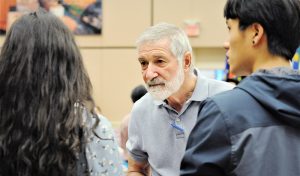The story of Shakyamuni’s disciple Kisa Gotami speaks eloquently to the universal suffering of death.
Kisa Gotami first loses her husband and then her beloved child. Inconsolable, she wanders through town, her dead child in her arms, begging for someone to bring her child back to life. Eventually, she encounters Shakyamuni Buddha, who tells her he will do as she wishes, save one condition: She has to return with a mustard seed from a family that has never experienced loss.
Kisa goes from one house to another. And while she encounters several families that have a mustard seed, none has escaped loss. Finally, it dawns on her: She is not alone; everyone experiences the pain and sorrow of losing loved ones. With this, she resolves to follow the Buddha’s teachings and achieves enlightenment.
Although death is one of the four universal sufferings, it can shatter our sense of self so completely that we may wonder whether it’s possible to become whole again.
How do Buddhists surmount the suffering associated with loss? In Nichiren Daishonin’s quest for the truth, he decided to first “learn about death, and then about other things.”[1] So, let’s examine Nichiren Buddhism’s unique and revolutionary perspective on life and death.
Life and Death: Two Functions of Myoho-Renge-Kyo
Life is eternal. From the Buddhist perspective, life and death are the two alternating phases of life; together, they make up a larger universal rhythm. Nichiren explains in one of his letters:
Myo represents death, and ho, life. … No phenomena—either heaven or earth, yin or yang, the sun or the moon, the five planets, or any of the worlds from hell to Buddhahood—are free from the two phases of life and death. Life and death are simply the two functions of Myoho-renge-kyo.”[2]
Waves appearing on the ocean’s surface can be likened to the relationship between life and death. The ocean symbolizes the Mystic Law of Nam-myoho-renge-kyo. When the conditions are right, a wave rises from the ocean’s surface, indicating life (ho), and when it merges back into the ocean, it represents death (myo).
From this perspective, life and death are simply two manifestations of the universe. When a wave recedes into the ocean, it is still part of the greater ocean that is the Mystic Law, or the life of the universe itself.
Ikeda Sensei writes of this liberating perspective:
In death, our life essence is like a current flowing within the ocean’s depths; it does not become fixed in one particular place. It pervades the universe and moves in sync with the cosmic rhythm of birth and death. … When life and death are viewed in terms of the Mystic Law, there is no need to fear death. Death for living beings in the world of Buddhahood means becoming one with the universe that overflows with the workings of compassion. Then, when we are reborn, embodying the compassion and life force of the universe, we once again take vibrant action and conduct ourselves in the manner of a Buddha—in other words, taking the greatest joy in respecting others and working to lead all people to enlightenment.[3]
In the Buddhist view of birth and death, the latent phase of death becomes a much-needed period of rest and replenishment for our next life, just like a good night’s sleep that energizes and revitalizes us for the next day.
Learning to Become Whole Again
While we can intellectually understand the eternity of life and death, this does not assuage the real pain we feel from losing those we love.
Working through feelings and emotions are part of the journey to overcoming our sorrow and grief, to learning to become whole again. In many of Nichiren Daishonin’s letters to his disciples, he expresses his condolences and empathizes with their suffering.
To Nanjo Tokimitsu, who had just lost his 16-year-old brother, Shichiro Goro, Nichiren writes:
Once a person is born that person must die—wise men and foolish, eminent and lowly alike all know this to be a fact. Therefore one should not be grieved and alarmed by a person’s death; I know it to be so and teach others to do likewise. And yet when something like this actually happens, I wonder if it is not a dream or an illusion. …
I can scarcely believe that such a thing has happened, and cannot even think of what words to write, though there is much more that I would say.[4]
Shortly after this letter, Nichiren wrote another one expressing his sincere empathy. In the two years between Shichiro Goro’s passing and Nichiren’s own death, he wrote eight letters to the Nanjo family in which he referred to the late Shichiro Goro, indicating his understanding that time does not diminish the grief of losing a loved one. Truly great was Nichiren’s compassion and empathy for those who were suffering.
While he grieved alongside and empathized with them, Nichiren reassured the Nanjo family that their deceased loved ones had without doubt attained Buddhahood. In a letter to the lay nun Ueno, Shichiro Goro’s mother, Nichiren encourages her as follows:
If all of you nurture the same seeds of Myoho-renge-kyo in your hearts, then you all will be reborn together in the same land of Myoho-renge-kyo. When the three of you are reunited there face to face, how great your joy will be![5]
Our three founding presidents also experienced the devastation of loss. Second Soka Gakkai President Josei Toda lost his own daughter and wife, but he regarded this suffering as the turning point for him to embark on a journey to gain a deeper understanding of life.
He writes:
The day my daughter died was the saddest day in my life. … I thought to myself, “What if my wife were to die?” That brought me to tears. And then my wife did indeed die. Later I wondered what I would do if my mother died. I was, of course, very fond of my mother. Pursuing things still further, I shuddered at the thought of my own death.
While in prison during the war, I devoted some time to reading the Lotus Sutra, and one day I suddenly understood. I had finally found the answer. It took me more than 20 years to solve the question of death. I had wept all night long over my daughter’s death, and I dreaded my wife’s death and the thought that I, too, would die. It’s because I could finally answer this riddle that I became the president of the Soka Gakkai.[6]
Buddhism teaches that by struggling to overcome the pain and sadness that accompanies death, we become more aware of the dignity of life and develop the spirit to share the sufferings of others as our own.
With strong faith, even the poison of death can become, for those who have survived, great medicine to live with deeper meaning.
Our Bonds Are Eternal and Indestructible
Some may feel that death means cutting all ties with the deceased. But that simply is not the case. The bonds we share with family and friends are eternal and indestructible.
The sound of our chanting Nam-myoho-renge-kyo has the power to reach and help even those in the state of death. Sensei reassures us: “Even if only one family member practices Nichiren Buddhism, the power of the Mystic Law is such that their benefit will permeate the lives of all their deceased family members and relatives.”[7] Thus, Buddhism affirms the strong bonds that we share with those close to us. In fact, we will definitely meet them again.
Nichiren Daishonin encourages the lay nun Ueno:
There is a way to meet [your deceased son] readily. With Shakyamuni Buddha as your guide, you can go to meet him in the pure land of Eagle Peak. … [The Lotus Sutra teaches that] it could never happen that a woman who chants Nam-myoho-renge-kyo would fail to be reunited with her beloved child.[8]
Sensei elaborates on the meaning of meeting on Eagle Peak, saying:
The word meet, we could say, is used here in the sense that when our lives after death fuse with the universal life, we can sense our unity or oneness with the lives of our deceased loved ones; or, in the sense that we can meet with our deceased loved ones again in the future, in some other Buddha land in the universe.[9]
Buddhism expounds the principle of the “oneness of life and death.” If the living family members are happy, those who have died will move on a course to happiness, too. Similarly, Sensei explains: “If the family members who have died attain Buddhahood, they will be able—as part of the protective forces of the universe with which they have merged—to protect their living family members.”[10]
With our loved ones ever in our hearts, we can press ahead in the journey to attain Buddhahood in this lifetime, and become unshakably happy.
Embracing the Deceased With the Light of Nam-myoho-renge-kyo
In Letter to Horen, Nichiren Daishonin tells his disciple Soya Kyoshin that his daily recitation of the Lotus Sutra assures his deceased father’s attainment of Buddhahood by relating the Chinese story of Wu-lung and I-lung, which can be summarized as follows:
A calligrapher named Wu-lung died, warning his son I-lung never to transcribe the Lotus Sutra. I-lung observed his father’s dying wish, but when forced by the ruler to transcribe the Lotus Sutra, he tearfully inscribed the sutra’s volume titles, writing: “Myoho-renge-kyo, Volume One” and so on for each volume. Feeling deep regret about disobeying his father’s wish, I-lung dreamed of his father Wu-lung. In the dream, Wu-lung shared how he had experienced excruciating agonies for having slandered the Lotus Sutra. All of a sudden, the characters myo, ho, renge and kyo written by I-lung came flying down to hell, where the letters turned into golden-hued Buddhas glowing and lighting up all of the hell of incessant suffering, saving Wu-lung.[11]
Our daily practice of gongyo and chanting Nam-myoho-renge-kyo is the greatest offering and the most profound tribute we can make to our deceased family members and friends. We transfer on to them the good fortune we accumulate through that daily practice and our SGI activities. In this way, both the living and the deceased can become happy together. Sensei speaks about our prayer for the deceased, saying:
When we chant to the Gohonzon, we can engage in an inner dialogue. Our chanting functions like radio waves, connecting our lives with those of our deceased loved ones.
Dedicating ourselves to kosen-rufu, living out our lives to the fullest and becoming as happy as we can, for the sake of our departed loved ones and friends—this is the best possible way to honor their memory.[12]
When we continue on the path of faith without retreating, we can transform all of our suffering into greater meaning. Sensei also writes:
Though the sadness of loss may linger, there will be no sense of loneliness. Tears of sorrow will eventually turn into fresh commitment. Surviving family, loved ones, and friends of the deceased will be able to look to the future with optimism. Family of the deceased, in particular, will gain the courage and energy to live to the fullest not only for themselves but for the deceased—striving not as mere “survivors” but as “successors” who share and carry on the deceased’s aspirations.[13]
Indeed, it is our Buddhist practice and SGI community that buoy us in times of sadness, so that we can transform all our sufferings and ensure that our loved ones become happy too.
—Prepared by the SGI-USA Study Department
References
- “The Importance of the Moment of Death,” The Writings of Nichiren Daishonin, vol. 2, p. 759. ↩︎
- “The Heritage of the Ultimate Law of Life,” WND-1, 216. ↩︎
- The Heritage of the Ultimate Law of Life: SGI President Ikeda’s Lecture Series, p. 36. ↩︎
- “Letter of Condolence,” WND-2, 887. ↩︎
- “Reply to the Mother of Ueno,” WND-1, 1074. ↩︎
- The Wisdom of the Lotus Sutra, vol. 4, pp. 8–9. ↩︎
- The Teachings for Victory, vol. 3, p. 75. ↩︎
- “The Gift of Clear Sake,” WND-1, 1092. ↩︎
- Discussions on Youth, p. 392. ↩︎
- Ibid., p. 399. ↩︎
- See “Letter to Horen,” WND-1, 516. ↩︎
- June 8, 2012, World Tribune, p. 5. ↩︎
- The Teachings for Victory, vol. 5, p. 146. ↩︎
You are reading {{ meterCount }} of {{ meterMax }} free premium articles





